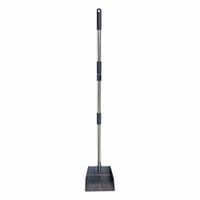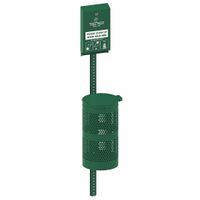Call +(254) 703 030 000 / 751 483 999 / 721 704 777
- Home
- Cleaning And Janitorial
- Waste Recycling Trash Supplies
- Pet Waste Disposal
.....Read More
Frequently Asked Questions
What are the best pet waste disposal products for public areas?
The best pet waste disposal products for public areas include:
1. **Pet Waste Stations**: These are comprehensive systems that include a waste bag dispenser and a waste bin. They are often made of durable materials like aluminum or steel to withstand weather conditions. Brands like Dogipot and Pet Waste Eliminator offer reliable options.
2. **Biodegradable Waste Bags**: Essential for environmentally friendly waste disposal, these bags break down naturally over time. Brands like Earth Rated and BioBag provide sturdy, eco-friendly options that fit most dispensers.
3. **Waste Bag Dispensers**: These can be standalone units or part of a waste station. They should be easy to refill and weather-resistant. Look for models with a lockable feature to prevent theft or vandalism.
4. **Dog Waste Bins**: Specifically designed for pet waste, these bins often have a lid to contain odors and prevent pests. They should be clearly marked and easy to empty. Brands like Glasdon and Toter offer durable options.
5. **Signage**: Clear, visible signs encourage pet owners to clean up after their pets. Signs should be weatherproof and placed at eye level for maximum visibility.
6. **Hand Sanitizer Dispensers**: Adding these near waste stations can promote hygiene among pet owners after handling waste.
7. **Portable Scoopers**: For areas where fixed stations aren't feasible, portable scoopers can be a practical solution. They allow for easy collection and disposal of waste without direct contact.
8. **Composting Systems**: For eco-conscious areas, pet waste composters can be installed to break down waste naturally. These systems require regular maintenance but offer a sustainable disposal method.
Selecting the right combination of these products can effectively manage pet waste in public areas, ensuring cleanliness and environmental responsibility.
How do pet waste stations work?
Pet waste stations are designed to provide a convenient and sanitary way for pet owners to dispose of their pets' waste in public areas. These stations typically consist of a few key components:
1. **Dispenser for Waste Bags**: The station includes a dispenser that holds rolls or stacks of biodegradable waste bags. Pet owners can easily pull out a bag to collect their pet's waste. The bags are often made from environmentally friendly materials to minimize ecological impact.
2. **Waste Receptacle**: Adjacent to the bag dispenser is a waste receptacle, usually a bin or container with a lid. This is where pet owners can dispose of the used waste bags. The receptacle is designed to contain odors and prevent pests from accessing the waste.
3. **Signage**: Most stations have clear signage that instructs pet owners on how to use the station properly. This may include reminders to pick up after their pets and instructions on how to use the bags and dispose of them in the receptacle.
4. **Maintenance**: Regular maintenance is crucial for the effective operation of pet waste stations. This involves restocking the bag dispenser, emptying the waste receptacle, and ensuring the area around the station is clean. Maintenance is typically handled by local municipalities, park services, or community organizations.
By providing these facilities, pet waste stations help keep public areas clean, reduce environmental contamination, and promote responsible pet ownership. They also contribute to public health by minimizing the spread of diseases that can be transmitted through pet waste.
Where can I buy pet waste bag dispensers?
You can buy pet waste bag dispensers at a variety of locations:
1. **Online Retailers**: Websites like Amazon, Chewy, and eBay offer a wide selection of pet waste bag dispensers. These platforms provide customer reviews, competitive pricing, and often have fast shipping options.
2. **Pet Supply Stores**: Chains such as PetSmart and Petco carry pet waste bag dispensers in-store and online. They offer various brands and styles, and you can often find them in the aisle with other pet accessories.
3. **Big Box Stores**: Retailers like Walmart and Target have pet sections where you can find waste bag dispensers. These stores offer both in-store shopping and online purchasing options.
4. **Grocery Stores**: Some larger grocery stores with pet sections, such as Kroger or Safeway, may carry basic pet waste bag dispensers.
5. **Home Improvement Stores**: Stores like Lowe’s and Home Depot sometimes stock pet waste bag dispensers, especially those designed for outdoor use.
6. **Specialty Pet Boutiques**: Local pet boutiques may offer unique or designer dispensers, often with a focus on eco-friendly or stylish options.
7. **Veterinary Clinics**: Some veterinary offices sell pet supplies, including waste bag dispensers, as a convenience for pet owners.
8. **Online Marketplaces**: Platforms like Etsy offer handmade or custom pet waste bag dispensers, often with unique designs.
9. **Discount Stores**: Stores like Dollar Tree or Dollar General may carry budget-friendly options for pet waste bag dispensers.
10. **Pharmacies**: Some larger pharmacy chains with pet sections, such as CVS or Walgreens, might stock basic dispensers.
These options provide a range of choices in terms of price, style, and convenience, allowing you to find a pet waste bag dispenser that suits your needs.
What are the benefits of using pet waste disposal products?
Pet waste disposal products offer several benefits:
1. **Hygiene and Sanitation**: These products help maintain cleanliness by effectively managing pet waste, reducing the risk of spreading bacteria and parasites that can cause diseases in humans and other animals.
2. **Environmental Protection**: Proper disposal prevents harmful pathogens from entering water systems, thus protecting aquatic life and maintaining ecological balance.
3. **Odor Control**: Many disposal products are designed to contain and neutralize odors, ensuring that living spaces remain fresh and pleasant.
4. **Convenience**: Products like waste bags, scoops, and disposal bins make the process of cleaning up after pets quick and easy, saving time and effort for pet owners.
5. **Compliance with Regulations**: In many areas, proper disposal of pet waste is a legal requirement. Using these products helps pet owners comply with local regulations and avoid fines.
6. **Aesthetic Appeal**: Keeping public and private spaces free of pet waste enhances the visual appeal of parks, sidewalks, and yards.
7. **Health Benefits**: Reducing exposure to pet waste minimizes the risk of zoonotic diseases, promoting better health for both humans and pets.
8. **Community Responsibility**: Using disposal products demonstrates responsible pet ownership and contributes to a cleaner, more pleasant community environment.
9. **Biodegradable Options**: Many products are eco-friendly, breaking down naturally and reducing the environmental footprint.
10. **Pet Training**: Consistent use of disposal products can aid in training pets to eliminate waste in designated areas, improving behavior and discipline.
Overall, pet waste disposal products are essential for maintaining a clean, healthy, and environmentally friendly living space.
How often should pet waste stations be serviced?
Pet waste stations should ideally be serviced at least once a week to ensure cleanliness and prevent overflow. However, the frequency can vary based on several factors:
1. **Location and Usage**: High-traffic areas, such as parks or apartment complexes with many pets, may require servicing multiple times a week. In contrast, less frequented areas might only need servicing every two weeks.
2. **Seasonal Changes**: During warmer months, waste can decompose faster, leading to stronger odors and attracting pests. This may necessitate more frequent servicing compared to cooler months.
3. **Capacity of the Station**: Larger stations with greater capacity might not need as frequent servicing as smaller ones. However, regular checks are essential to prevent unexpected overflows.
4. **Community Feedback**: Pay attention to feedback from the community. If residents or users report issues with overflowing bins or unpleasant odors, it may be necessary to increase the servicing frequency.
5. **Environmental Considerations**: In areas with strict environmental regulations, more frequent servicing might be required to comply with local laws regarding waste management and sanitation.
6. **Weather Conditions**: Adverse weather conditions, such as heavy rain or snow, can affect the accessibility and condition of waste stations, potentially requiring more frequent checks and servicing.
Regular monitoring and adjustments based on these factors can help maintain hygiene and ensure the stations are effectively serving their purpose.
Are there eco-friendly pet waste bags available?
Yes, there are eco-friendly pet waste bags available. These bags are designed to minimize environmental impact compared to traditional plastic bags. They are typically made from biodegradable or compostable materials, such as cornstarch, vegetable-based plastics, or other plant-derived substances. These materials break down more quickly and safely in the environment, reducing the long-term pollution associated with conventional plastic bags.
Some eco-friendly pet waste bags are certified by organizations like the Biodegradable Products Institute (BPI) or meet standards such as ASTM D6400, which ensures they will decompose under specific conditions. Compostable bags are designed to break down in industrial composting facilities, but some can also decompose in home composting systems, provided they meet the necessary conditions of heat, moisture, and microbial activity.
In addition to the materials used, eco-friendly pet waste bags often come in minimal or recyclable packaging to further reduce their environmental footprint. Some brands also focus on ethical production practices, ensuring that their manufacturing processes are sustainable and socially responsible.
When choosing eco-friendly pet waste bags, it's important to consider the specific environmental claims made by the manufacturer and verify any certifications. While these bags are a more sustainable option, proper disposal is still crucial. Compostable bags should be disposed of in appropriate composting facilities, and biodegradable bags should be placed in trash systems where they can break down effectively.
Overall, eco-friendly pet waste bags offer a more sustainable alternative for pet owners looking to reduce their environmental impact while managing pet waste responsibly.
How can I encourage people to use pet waste disposal stations?
To encourage people to use pet waste disposal stations, start by ensuring these stations are conveniently located in high-traffic areas such as parks, trails, and residential neighborhoods. Visibility is key, so use clear signage that directs pet owners to the stations. Educate the community about the environmental and health benefits of proper pet waste disposal through flyers, social media campaigns, and community meetings. Highlight how it prevents water pollution and reduces the spread of diseases.
Incentivize usage by organizing community events or challenges that reward responsible pet owners with small prizes or recognition. Partner with local businesses to sponsor these events, providing mutual benefits. Ensure the stations are well-maintained and stocked with bags to prevent frustration and encourage consistent use.
Engage local influencers or community leaders to advocate for the cause, as their endorsement can significantly impact public behavior. Additionally, involve children and schools in educational programs about pet waste management, as they can influence their families' habits.
Implement a feedback system where users can report issues or suggest improvements, making them feel involved and valued. Finally, consider local regulations or ordinances that mandate pet waste disposal, coupled with gentle enforcement and community support, to ensure compliance.



